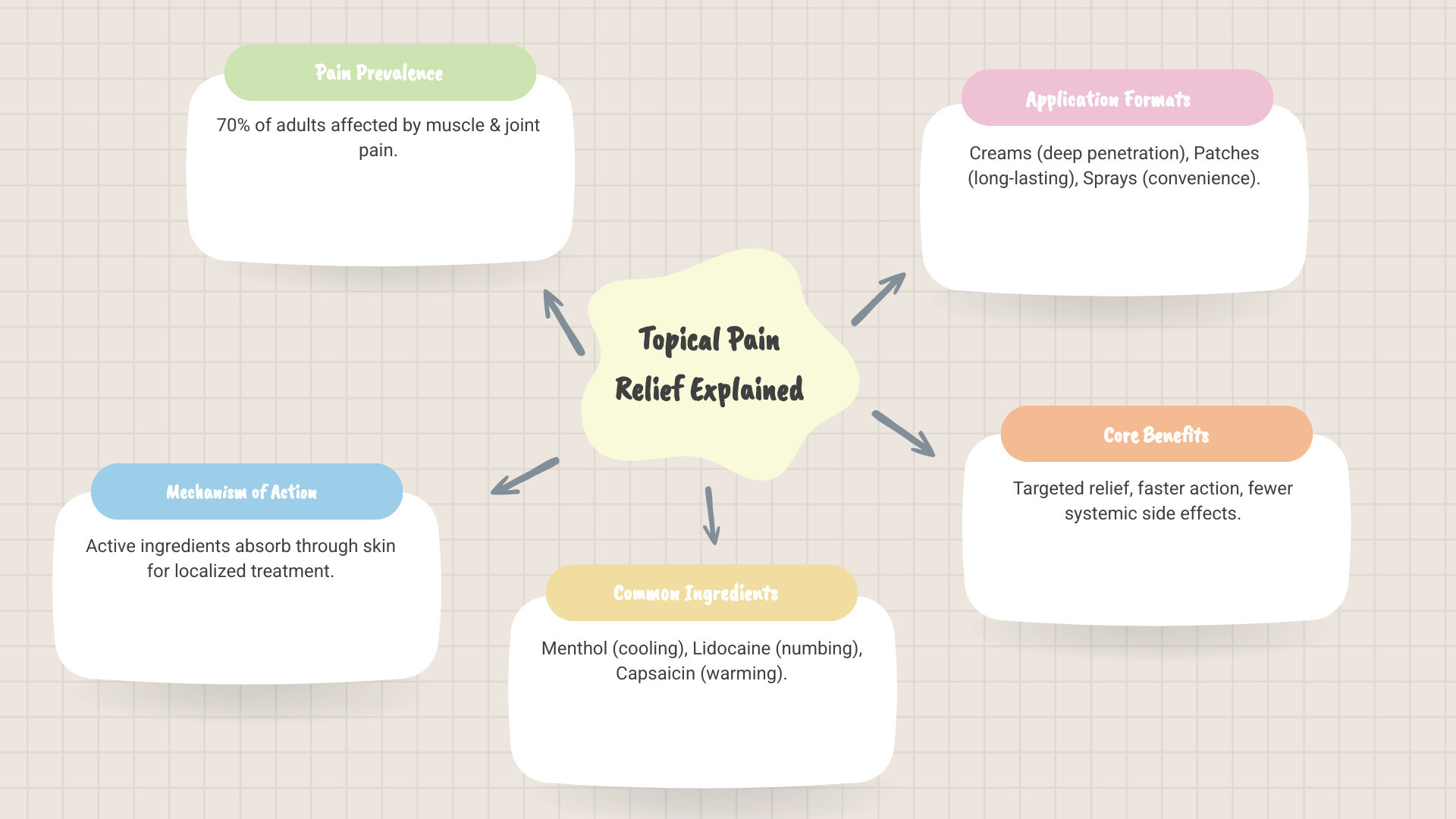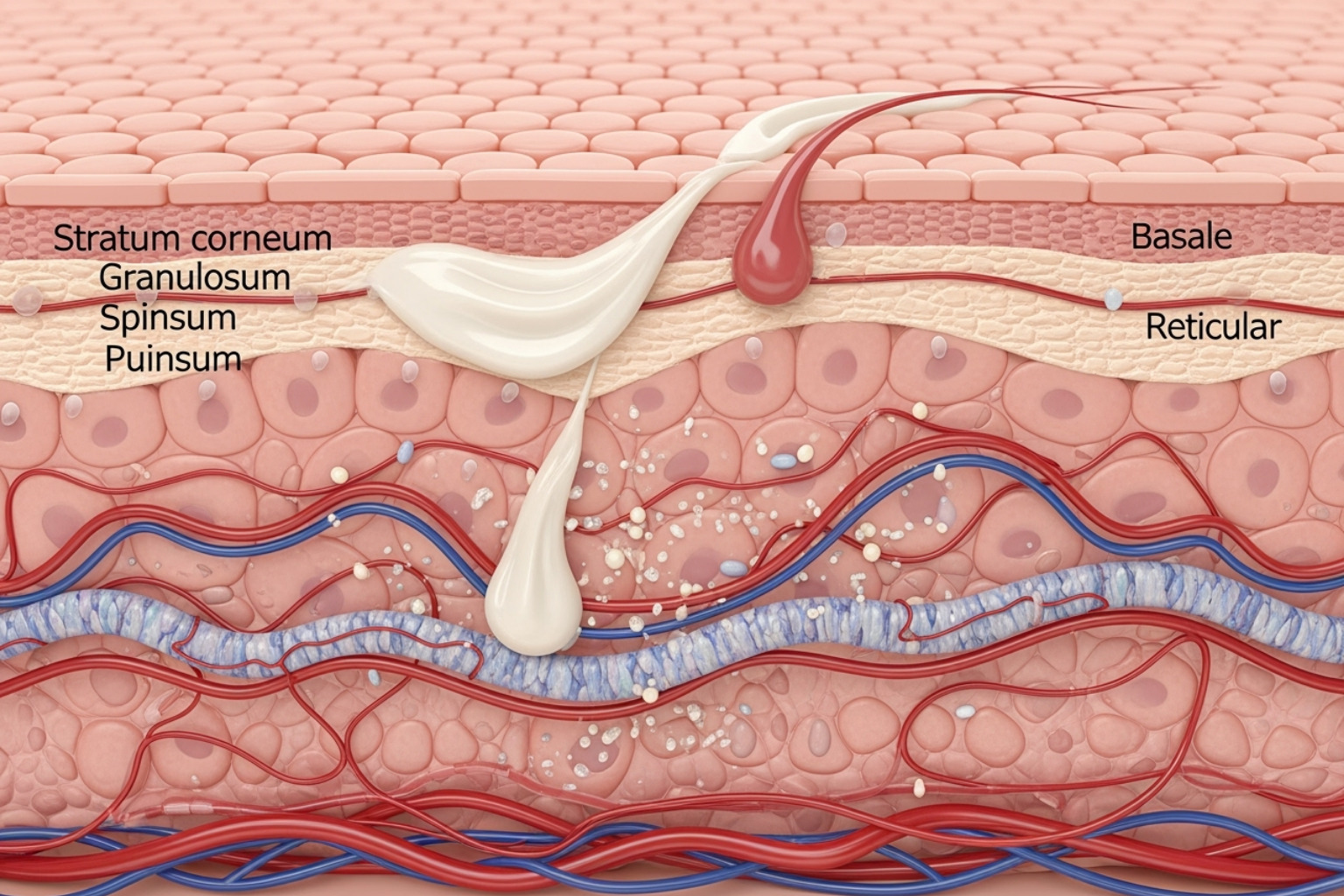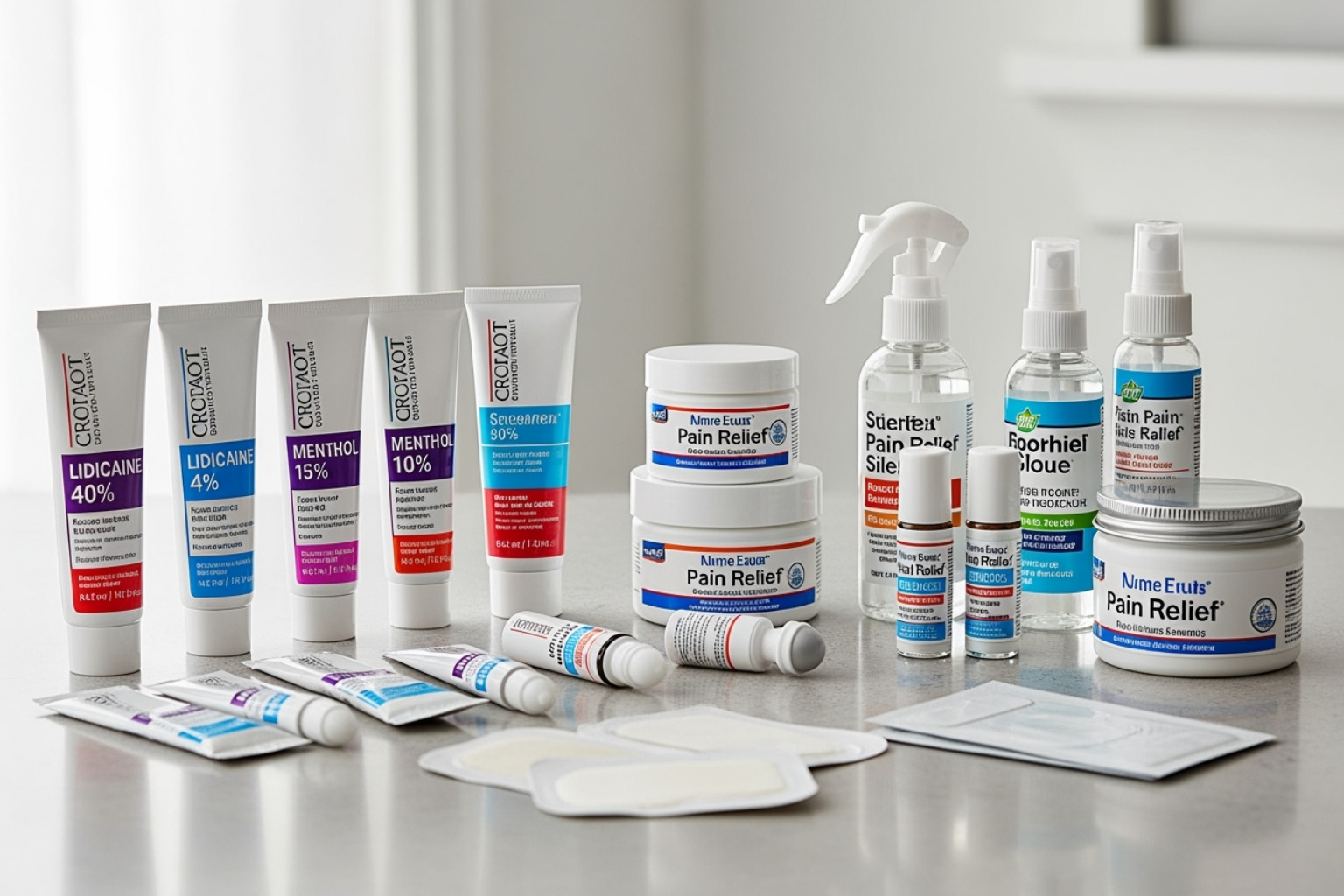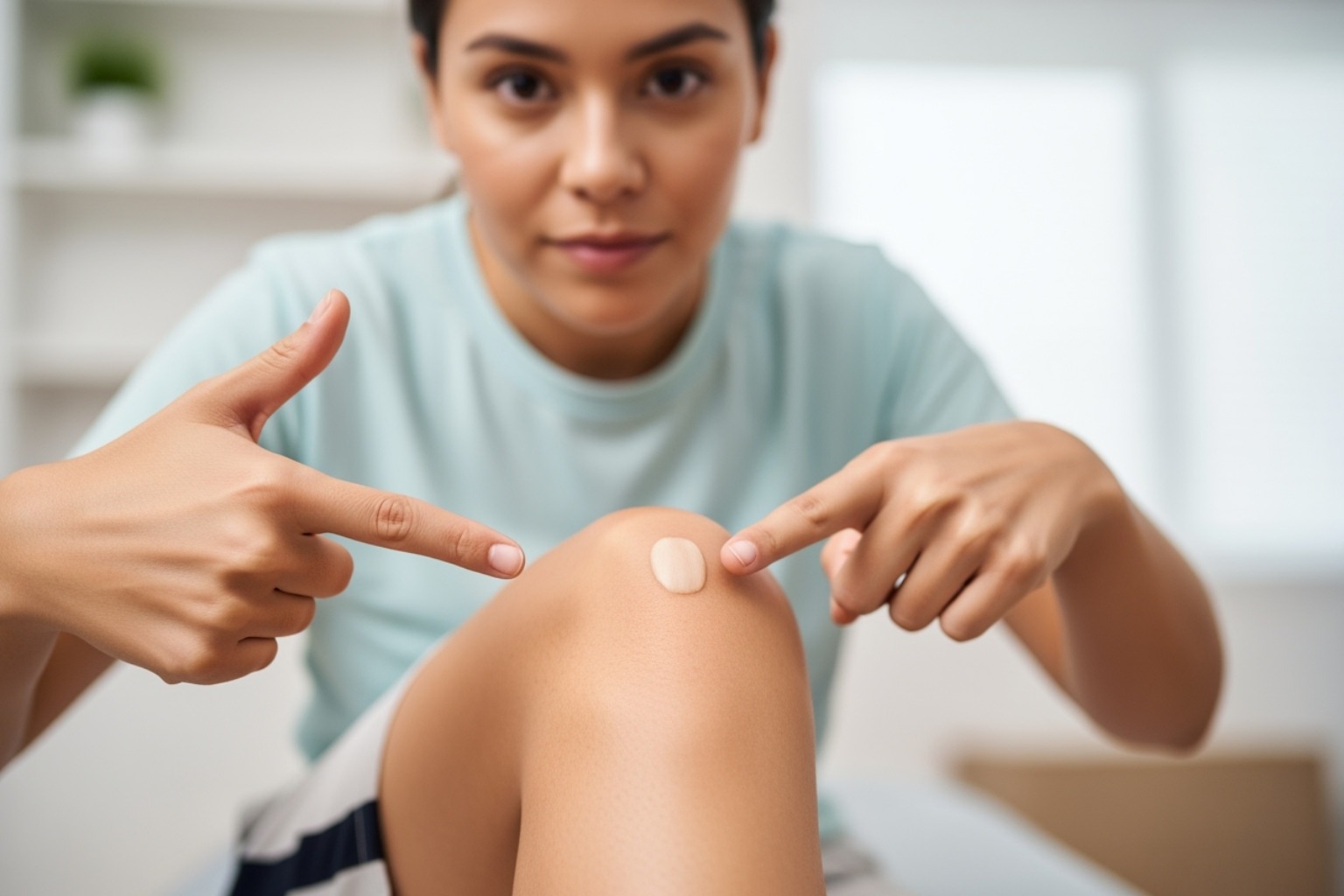Understanding Your Topical Pain Relief Options
Pain killing ointment offers targeted relief for muscle aches, joint pain, and nerve discomfort, often without the systemic side effects of oral medications. Here's a brief overview of topical pain relievers:
Common Types:
- Counterirritants (menthol, camphor) - create cooling/warming sensations
- Anesthetics (lidocaine 4%) - numb pain signals
- Anti-inflammatories (diclofenac) - reduce swelling
- Natural ingredients (capsaicin, arnica) - provide gentle relief
Available Formats:
- Creams and gels for deep absorption
- Patches for long-lasting relief
- Sprays for hard-to-reach areas
Topical analgesics deliver active ingredients directly through your skin to the source of pain. This targeted approach can mean faster relief with fewer systemic side effects compared to pills, whether you're dealing with post-workout soreness, arthritis, or sciatica. From maximum-strength lidocaine to natural herbal remedies, today's pain killing ointment options provide effective alternatives to oral medications.
I'm Tony Enrico. At Neuropasil, I've focused on developing advanced pain killing ointment formulations that combine natural ingredients like menthol, aloe, and panthenol. Our goal is to create non-greasy, quick-absorbing solutions for athletes and active adults seeking fast-acting, natural pain management.

Understanding Topical Analgesics: How They Work
When pain strikes, you want relief that's fast and targeted. Topical painkillers deliver active ingredients right where you need them, bypassing your digestive system.
Unlike pills that circulate throughout your body, topical analgesics provide localized treatment. You apply them directly to the skin over an aching shoulder, sore knee, or tight back. This targeted approach is highly effective for everything from workout soreness to chronic joint pain.

The Science Behind Topical Pain Relief
The effectiveness of topical pain relief lies in its targeted delivery system. Medication is absorbed directly through your skin to the source of discomfort, rather than traveling through your bloodstream.
This skin absorption process has key advantages. With less medication entering your general circulation, you'll likely experience reduced systemic side effects compared to oral pain relievers, avoiding common issues like stomach upset or drowsiness. Many users also notice faster action because the medication doesn't need to be digested first. For more details on how these treatments work, check out this gel muscle pain relief guide.
Common Active Ingredients and Their Mechanisms
The power of any pain killing ointment is in its active ingredients. Understanding how they work helps you choose the right product for your needs.
Counterirritants like menthol, camphor, and methyl salicylate create a cooling sensation or warming sensation on your skin. This distracts your brain from the underlying pain.
Anesthetics numb the area directly. Lidocaine 4% is a common over-the-counter option, while pramoxine is another effective choice for numbing nerves. These ingredients block pain signals from reaching your brain.
Capsaicin, from chili peppers, works by depleting substance P, a neurotransmitter that sends pain signals. Regular use can significantly reduce chronic pain.
Salicylates like trolamine salicylate provide an aspirin-like effect when absorbed through the skin, making them useful for joint pain in areas like fingers and knees.
NSAIDs in topical form, such as diclofenac, focus on inflammation reduction. These are often prescription-strength options that target swelling at the source.
Natural ingredients offer gentler alternatives. Arnica has anti-inflammatory properties, while comfrey root extract can promote healing. At Neuropasil, we combine natural ingredients like aloe, urea, and menthol to create powerful, soothing relief.
For more pain management insights, the Pain Topics Blog offers valuable resources.
Over-the-Counter (OTC) vs. Prescription Pain Killing Ointment
Knowing the difference between OTC and prescription topicals helps you decide when to self-treat versus when to call your doctor.
OTC availability means you can find effective relief without a prescription. These products contain lower concentrations of active ingredients, like lidocaine 4% or moderate amounts of menthol and camphor. They work well for many everyday aches and pains.
Prescription strength formulations are more potent. These may include higher concentrations of lidocaine (lidocaine 4% vs 5%) or topical NSAIDs like diclofenac 1%. These stronger formulations are for more severe or chronic pain.
When to see a doctor is key. If OTC products don't provide relief after a week, or if you have a chronic condition like severe arthritis or neuropathy, it's time to discuss prescription options with your doctor.
Choosing Your Weapon: A Guide to Pain Relief Formats
Choosing a pain killing ointment format is like picking the right tool for a job. The application method can significantly impact effectiveness and convenience. Your main options are creams, gels, and ointments; patches for long-term wear; and sprays and roll-ons for quick, mess-free treatment. Understanding their differences will help you select the best option for your needs.

Creams, Gels, and Ointments
These traditional formats are the workhorses of topical pain relief. Massaging them into the skin provides the dual benefit of medication and therapeutic touch.
Fast-absorbing formulas, like our Neuropasil creams, sink in quickly without a greasy residue. Many also offer moisturizing properties, which is a plus for dry skin. The massage action helps drive active ingredients deeper into the tissue.
The main drawback is that application can be messy, requiring hand washing afterward. Some products may also have strong odors or stain clothing. However, for massaging into muscles and joints, the hands-on approach is highly effective.
These formats are ideal when you can take time to massage the product into a specific muscle knot or painful joint. For more guidance, see The Ins and Outs of Best Pain Relief Creams for Muscle Pain.
Patches
For convenience, patches are hard to beat. They deliver long-lasting relief for 8-12 hours or more, eliminating the need for frequent reapplication.
Patches are mess-free, discreet, and won't get on your clothes, making them ideal for all-day use, especially for chronic pain management.
However, they have downsides. Adhesion issues can occur, especially on hairy skin or with sweating. They also work best on flat body areas and may not stick well to joints like elbows or ankles.
Patches are best for sustained, targeted pain, such as chronic back or shoulder discomfort, where steady relief is needed without hassle.
Sprays and Roll-Ons
For quick, fuss-free relief, sprays and roll-ons are excellent. They are perfect for hard-to-reach areas, like the middle of your back.
With no-mess application and quick-drying formulas, they fit easily into a busy lifestyle. They are also great for efficiently covering large areas of soreness.
The trade-off is that they are often less concentrated than creams, so you may need to reapply more often. With sprays, there is also a risk of inhalation if not applied carefully.
These formats are best for large areas and on-the-go use, such as before or after physical activity or for widespread discomfort.
Comparing Topical Formats
| Feature | Creams, Gels, Ointments | Patches | Sprays & Roll-Ons |
|---|---|---|---|
| Application Ease | Moderate (requires rubbing) | Easy (apply and forget) | Very Easy (quick, no-touch) |
| Duration of Relief | Variable (reapply every 4-8 hours) | Long-lasting (8-12+ hours) | Shorter (reapply every 3-6 hours) |
| Best Use Case | Targeted massage, deep muscle/joint pain, moisturizing | Sustained relief, discreet, chronic localized pain | Hard-to-reach areas, quick application, large areas |
| Messiness Level | Moderate (requires hand washing) | Low (no residue) | Low (quick-drying, no-touch) |
Finding the Right Pain Killing Ointment for Your Ailment
Effective pain relief means matching the right pain killing ointment to your specific discomfort. A cream for muscle soreness may not work for nerve pain. Understanding which ingredients target which types of pain is key to finding real relief.

For Muscle Aches, Strains, and Sprains
When you've overdone it at the gym or woken up with a stiff neck, counterirritants are your best bet. These ingredients create sensations that distract your brain from the pain.
Menthol provides a cooling sensation that soothes tight muscles. Camphor delivers warming relief that helps increase blood flow. Methyl salicylate adds an aspirin-like effect that penetrates deep into muscle tissue.
Products combining these ingredients are excellent choices for strains, bruises, and sprains. For athletes, natural formulations can be especially appealing. Our Neuropasil creams use aloe, urea, and menthol to help muscles recover while providing soothing relief. We've seen how Neuropasil helps athletes with muscle recovery & pain, getting them back to peak performance.
For Joint Pain and Arthritis
Joint pain often requires a focus on inflammation. Whether it's arthritis, an overuse injury, or general stiffness, certain ingredients excel at targeting this type of discomfort.
Diclofenac is a topical NSAID that reduces inflammation at the source, making it effective for conditions like knee osteoarthritis. It offers targeted relief without the stomach concerns of oral NSAIDs.
Capsaicin, derived from chili peppers, is remarkably effective for chronic joint pain. It works by depleting substance P, a chemical that transmits pain signals to the brain.
Salicylates provide aspirin-like relief that works well for joints close to the skin's surface, such as in the fingers and knees.
If joint pain is persistent, consult a specialist. You can find an orthopedist who can provide comprehensive treatment options.
For Nerve Pain (Neuropathy, Sciatica)
Nerve pain—often a burning, tingling, or shooting sensation—requires ingredients that directly interact with nerve signals.
Lidocaine 4% is a topical anesthetic that works by temporarily blocking nerve signals, providing numbness to the affected area. It is often combined with menthol 1% for both numbing and a cooling distraction.
For conditions like neuropathy, sciatica, fibromyalgia, and plantar fasciitis, specialized formulations often provide the best results. Our Neuropasil creams were specifically developed for nerve pain, combining aloe, urea, and menthol for targeted, soothing relief. We have focused our research on nerve pain relief with Neuropasil natural solutions.
For Minor Cuts, Burns, and Insect Bites
For minor skin injuries, you want both pain relief and protection from infection.
Lidocaine and pramoxine are topical anesthetics that soothe pain and itching from minor cuts, insect bites, and burns. Some creams combine these anesthetics with antibiotic ingredients to provide pain relief while helping to prevent infection in minor cuts, scrapes, and burns. Fast-acting ointments can provide relief within minutes for skin irritations.
For proper care, it's helpful to learn about first aid for minor injuries to ensure you're treating them safely and effectively.
Safe Application and Important Precautions
Using any pain killing ointment safely should be your top priority. Following proper guidelines ensures you get maximum benefits while minimizing potential risks.

How to Use Topical Pain Relievers Correctly
Proper application technique is key to getting the most from your topical pain reliever.
- Wash your hands thoroughly with soap and water before and after application. This prevents contamination and stops you from accidentally getting medication in your eyes or mouth.
- Prepare the area by ensuring your skin is clean and completely dry. Moisture or dirt can interfere with absorption.
- Apply a thin layer. More is not better. Gently massage the product into your skin until it's fully absorbed.
- Never apply to broken skin, including cuts, scrapes, open wounds, or rashes. Damaged skin can absorb too much medication.
- Keep away from sensitive areas like your eyes, mouth, nose, and genitals. If accidental contact occurs, rinse immediately with plenty of water.
- Never use a heating pad with counterirritant creams (containing menthol, camphor, or capsaicin). The combination can cause severe burns.
- Avoid tight bandages or plastic wrap over the treated area, as this can also increase absorption to unsafe levels. Light, breathable coverings are acceptable.
Potential Side Effects and What to Watch For
While generally well-tolerated, skin reactions can occur.
Common, mild reactions include slight skin irritation, redness, or a mild burning sensation, especially with counterirritants. These sensations should be tolerable and not worsen.
More concerning signs that could indicate an allergic reaction include severe burning, intense itching, hives, swelling, or blistering. If you experience any of these, stop using the product immediately and wash the area thoroughly with soap and water.
When to See a Doctor Instead of Self-Treating
Topical relievers are great for many aches, but sometimes professional medical care is necessary.
Consult a healthcare provider if your pain worsens, persists for more than 7 days, or clears up only to return within a few days. This may signal an underlying issue.
Serious injuries from trauma like falls or accidents require professional evaluation. Do not self-treat if you suspect a fracture or severe sprain.
Watch for signs of infection, such as increased redness, swelling, warmth, pus, or fever. These symptoms require medical attention.
Neurological symptoms like numbness, tingling, or weakness that spread beyond the original area also warrant a doctor's visit.
If you have special circumstances, such as diabetes, poor circulation, or are pregnant or breastfeeding, always check with your doctor before using any new pain relief product. For more guidance on specific conditions, our article on Cream for Tendonitis provides helpful insights.
Beyond Ointments: Hot & Cold Therapy Explained
Sometimes, the most effective pain relief doesn't come from a tube. Hot and cold therapy are time-tested, non-medicinal methods that work well on their own or as a complement to your favorite pain killing ointment.
Cryotherapy (cold) calms inflammation and numbs pain, while thermotherapy (heat) relaxes tight muscles and boosts circulation. Each approach is valuable for different types of pain and stages of healing.
How Cold Therapy (Cryotherapy) Works
Cold therapy acts as a natural anesthetic. Applying cold to an injury numbs pain by temporarily slowing down pain signals. It also constricts blood vessels, which reduces swelling and inflammation by limiting fluid buildup in the injured area. Less swelling means less pressure and less pain.
Cold therapy is most effective for acute injuries within the first 24-48 hours. It works well for sprains, fresh muscle strains, and arthritis flare-ups when inflammation is at its peak.
How Heat Therapy (Thermotherapy) Works
Heat therapy is wonderfully effective for different kinds of pain. Applying heat relaxes muscles and eases tension. It works by dilating blood vessels, which increases blood flow to the area, delivering oxygen and nutrients that promote healing.
Heat also helps decrease pain sensation by soothing irritated nerve endings. This makes it ideal for chronic muscle stiffness, general soreness, and aches from poor posture. Many people find heat therapy helpful before activity to warm up stiff joints and muscles.
Combining Therapies with Your Pain Killing Ointment
Combining these therapies with topical relievers can improve relief, but safety first is crucial.
The most important rule: never use a heating pad with counterirritant creams containing menthol, camphor, or capsaicin. This combination poses a serious risk of burns because heat dangerously intensifies the ingredients' effects.
Alternating therapies can be effective. You might use cold first to reduce initial swelling, then switch to heat later to address stiffness. This multi-angled approach can be very effective, but always read product labels carefully. When in doubt, consult a professional to find the safest and most effective combination for your situation.
Conclusion
We've explored a wide range of options for managing aches and pains with pain killing ointment. The key takeaway is that there is a diverse toolkit available, from counterirritants that create cooling or warming sensations to anesthetics that numb pain and anti-inflammatory ingredients that reduce swelling.
The format is just as important as the ingredients. Whether you need the deep massage of a cream, the long-lasting convenience of a patch, or the quick application of a spray, there is a solution to fit your lifestyle.
The most effective approach is to match the product to your specific type of pain. Use counterirritants like menthol and camphor for muscle soreness, consider diclofenac or capsaicin for aching joints, and look to lidocaine for nerve-related pain like neuropathy or sciatica.
Safety is paramount. Always wash your hands, apply to clean, intact skin, and never combine counterirritant creams with heating pads. It's also crucial to know when to see a doctor. Pain lasting more than seven days, worsening symptoms, or signs of infection warrant professional medical attention.
At Neuropasil, we are excited by the power of natural solutions. We've seen how combining Aloe Vera, Urea, and Menthol creates fast-acting, gentle relief. Our customers rely on our natural formulas to manage everything from neuropathy and fibromyalgia to post-exercise muscle soreness.
The ultimate goal is simple: find targeted relief so you can get back to the life you love. The right pain killing ointment can be a true life-changer, helping you move comfortably and sleep soundly.
As you explore your options, finding what works for you may take some trial and learning. For those ready to find natural, targeted solutions for muscle and nerve pain, we invite you to find how our carefully crafted formulations can fit into your wellness routine. You can find the best products for your muscle pain and take a step toward more comfortable days.














